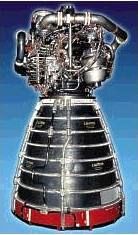
Home - Search - Browse - Alphabetic Index: 0- 1- 2- 3- 4- 5- 6- 7- 8- 9
A- B- C- D- E- F- G- H- I- J- K- L- M- N- O- P- Q- R- S- T- U- V- W- X- Y- Z
SSME
 SSME Credit: Boeing / Rocketdyne |
AKA: RS-24;RS-25. Status: In production. Date: 1972. Number: 351 . Thrust: 2,278.00 kN (512,114 lbf). Unfuelled mass: 3,177 kg (7,004 lb). Specific impulse: 453 s. Specific impulse sea level: 363 s. Burn time: 480 s. Height: 4.24 m (13.92 ft). Diameter: 1.63 m (5.36 ft).
The Space Shuttle Main Engines was the only high-pressure closed-cycle reusable cryogenic rocket engine ever flown. Three of these engines were mounted in the base of the American space shuttle, and were fed liquid hydrogen and liquid oxygen propellants from the Space Shuttle external tank during ascent to orbit. The external tank was released when the desired orbit was attained, and the shuttle returned the engines to earth for reuse. The original design points for the engines were ten flights between overhaul and a vacuum specific impulse of 455 seconds. Neither goal was achieved - vacuum impulse was 453 seconds, and the engines had to be pulled, inspected, and refurbished after each flight. In the end, the shuttle proved to a very expensive method of recovering reusable engines that perhaps cost more than expendable ones….
Fuel and oxidizer were pumped from the external tank by high pressure oxidizer and fuel turbopumps (HPOT and HPFT) mounted to each engine assembly. To prevent cavitation, the flow was boosted before entry into these pumps by low pressure oxidizer and fuel turbopumps (LPOT and LPFT). The propellant flow was tapped off during operation for a variety of purposes, including pressurization of the external fuel and oxidizer tanks and operating the LPOT and LPFT. Liquid hydrogen was pumped through the combustion chamber and engine nozzle to cool them before being discharged into the combustion chamber.
The now-gaseous hydrogen and liquid oxygen entered the chamber at the injector, which mixed the propellants. A dual-redundant igniter was used during the engine start sequence to initiate combustion.
The SSME could be throttled between 67% and what NASA called "109%" of its rated thrust. Launches normally used 104% (2170 kN) as a maximum, with 109% (2280 kN) reserved for abort emergency situations.
After NASA's decision to retire the Shuttle fleet in 2010, there was an attempt to keep the SSME in production as the second stage engine of the Ares I launch vehicle and the booster stage engine of the Ares V. However the uneconomical nature of continued SSME use became apparent, and NASA finally settled on an expendable J-2X engine for the Ares I and the RS-68 for the Ares V.
The SSME was naturally considered for the many shuttle derivatives and upgrades proposed during its forty-year development and service life. In the end, it appeared to be a technological bridge too far - the specified weight, reliability, durability, and reusability simply could not be met in a single engine using existing or foreseen technology and materials.
Thrust (sl): 1,817.400 kN (408,568 lbf). Thrust (sl): 185,330 kgf. Engine: 3,177 kg (7,004 lb). Chamber Pressure: 204.08 bar. Area Ratio: 77.5. Thrust to Weight Ratio: 73.1197829645898. Oxidizer to Fuel Ratio: 6. Coefficient of Thrust vacuum: 1.90710733043191. Coefficient of Thrust sea level: 1.52735733043191.
| SSME Demonstrator Booster Rocketdyne LOx/LH2 rocket engine. Pressure-fed. |
| STME Rocketdyne LOx/LH2 rocket engine. Cancelled 1984. Space Transportation Main Engine. Rocketdyne was teamed with Aerojet and Pratt & Whitney on the STME, which was to have powered the next generation of large launch vehicles. |
| SSME Plus Notional LOx/LH2 rocket engine. VTOHL studies, 1978. |
| SSME Study Notional LOx/LH2 rocket engine. Study 1967. |
Country: USA. Spacecraft: NASA Mars Expedition 1971. Launch Vehicles: Space Shuttle, Saturn Shuttle, Shuttle LRB, Shuttle ASRM. Propellants: Lox/LH2. Stages: Starlifter, Shuttle Orbiter, Ares Stage 1, Magnum Core, Cargo LV Stage 1, CLV Stage 2. Agency: Rocketdyne. Bibliography: 225.
Back to top of page
Home - Search - Browse - Alphabetic Index: 0- 1- 2- 3- 4- 5- 6- 7- 8- 9
A- B- C- D- E- F- G- H- I- J- K- L- M- N- O- P- Q- R- S- T- U- V- W- X- Y- Z
© 1997-2019 Mark Wade - Contact
© / Conditions for Use